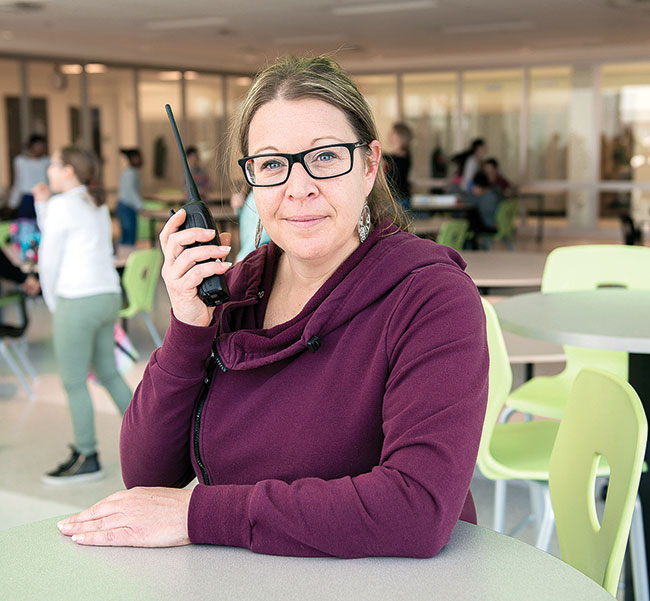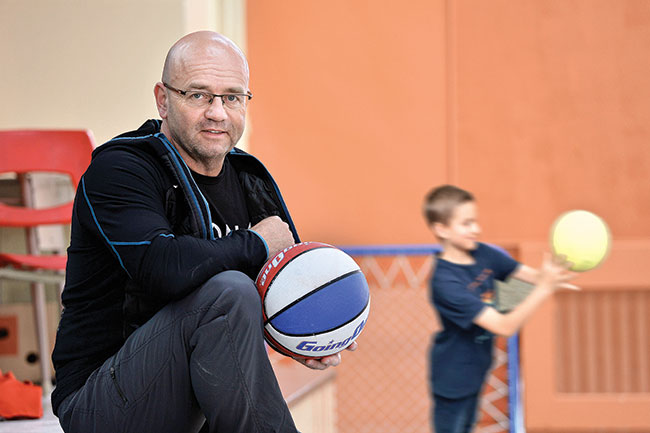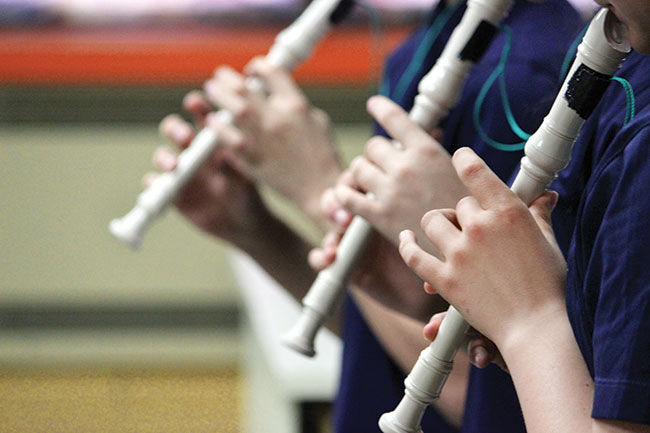In education and early childcare, workplaces are noisy. It’s no surprise that personnel are more vulnerable to hearing loss than workers in other professions. Since the effects of noise pollution are cumulative and hearing loss can become irreversible, it’s best to address it before it’s too late.
The magnitude of the phenomenon is underestimated
According to Health Canada, the extent of the phenomenon is generally underestimated even though it is one of the most common hazards in the workplace. In Québec, the Institut national de santé publique (INSPQ) is troubled by increasing occupational deafness when means exist to prevent it.

Sound or noise: what’s the difference?
Just like sound, noise is an auditory sensation created by acoustic waves of varying frequencies (high or low), intensities (loud or weak), and length. What’s the difference? Ingrid Verduyckt1 explains: “Noise is any kind of unwanted sound that interferes with our auditory perception of what we want to hear. Therefore, noise depends on our own subjective perception, which changes with age, gender or personal experience.”
Beware of excess noise
The risks to auditory health therefore depend on noise levels, and the duration and accumulation of exposure to noise. In fact, Health Canada recommends taking into account all of the noise we’re exposed to daily. If it regularly exceeds the limit, the amount of noise we experience every day may represent a danger to our hearing.
Besides auditory fatigue (a temporary decrease in hearing), prolonged overexposure to noise levels that exceed recommended limits may cause progressive hearing loss, tinnitus, and hyperacusis (intolerance for normal sounds), and more.
And that’s not all: noise can also have negative effects on heart rate, stress, and sleep, in addition to causing headaches, increased fatigue, irritability and impatience, voice disorders, decreased concentration, and job dissatisfaction.
Outdated regulations
In Québec, the Regulation respecting occupational health and safety has set to 90 dB and 8 hours the maximum values for exposure to continuous noise to prevent occupational deafness, compared to 85 dB in most other provinces.
“It should be noted that this standard has not changed since 1979. Yet, it has been generally accepted by both science and the Québec courts that the risk of impairment is possible when exposed for extended periods of time to noise levels lower than the standards set in Québec,” warns Mélanie Baril.2
She adds that the CNESST3, which has reported an increase in the number of cases of occupational deafness since 2004, is currently working on the regulatory aspects of this issue. “Workplaces must address the issue of noise, even if it is below the standards. Occupational health and safety committees should address it in order to find solutions that will allow to reduce its significant impact on workers’ health,” she says.
The dance of the decibels
Studies in Québec and elsewhere have shown that the noise level in childcare centres and home childcare centres ranges between 56 and 71 dB, peaking as high as 80 to 95 dB.
In schools, the intensity of noise observed in classrooms ranges from 57 to 70 dB, peaking at 97 dB. In music rooms, gymnasiums, cafeterias, and schoolyards, the intensity varies between 80 and 90 dB, peaking at over 100 dB. Worse still, overpopulation in some schools, combined with dilapidated buildings, accentuate this serious yet still grossly underestimated problem.
Education workers at risk
European studies on the effects of noise on teachers are very revealing. It has been shown that 82% are exposed to noise for approximately one quarter of their work time. They must speak louder and repeat instructions, which in the long term affect their voice capacity.
Other studies suggest that more experienced teachers tolerate noise less than they did earlier in their careers. Many also complain of hearing impairments. In addition, a significant proportion is more tired at the end of the day and has trouble sleeping.
Similar situation in early childcare
Noisy early childcare environments (home-based and in centres) also increase the stress felt by workers. In addition to vocal fatigue, educators are more vulnerable to extreme fatigue, find it more difficult to tolerate noise at home, and develop sleep problems.
Childcare centres in turmoil
In schools, noise levels vary with activities. Annick Béland4 knows something about it. She is an educator in the childcare centre at École primaire Val-des-Ruisseaux in Laval.
We interviewed her in the school cafeteria at lunchtime. In no time, we had to raise our voices to be heard. A few times, she had to yell to calm the enthusiasm of noisier students. Games, sports, and the movements and meetings of her group are all part of her daily routine.
“My colleagues and I constantly wear walkie-talkies. In one day, I can make 160 calls on this device. It can very quickly become a source of irritation since we can’t rid ourselves of it. We need it for communication and safety reasons,” she says.
At night, she enjoys the silence just like her colleagues who regularly lose their voices. During the interview, we crossed a physical education teacher who has lost more than 20% hearing in one ear. As for the brand new gymnasium, it wasn’t built with acoustic panels...
In another school, a childcare educator, whose name cannot be mentioned due to actions underway, has lost 80% of her hearing. Is the issue of noise pollution taken seriously enough? Doubtful.

Gymnasiums: exceptionally noisy environments
Alain Vachon5 has been teaching physical education for 20 years at École Sainte-Cécile in Jonquière. He suffers from significant hearing loss. It’s not surprising when we know that noise levels often exceed 100 dB in gymnasiums.
After sharing his problem during a meeting, his union suggested that he and three other teachers participate in a special OHS pilot project that aims to evaluate the effectiveness of molded ear protectors (earplugs) with acoustic filters.
“The experience was very illuminating. At the beginning, I was surprised because the sound of the whistle and other background noises were significantly reduced, but I could still hear voices well and communicate easily with the students,” he said with satisfaction.
These molded earplugs are perfectly fitted to individual ears and can be removed and reinserted quickly. As a means of prevention, Alain Vachon wholeheartedly recommends their use to his teachers in training.

A proactive union
Claude Bradet6 rejoices at the school board’s attentiveness to this issue. He explains that the pilot project was a success: “The project will be expanded to teachers who work in other high-risk noisy areas, such as music rooms, woodworking shops, and some vocational training programs.”
“These molded earplugs with acoustic filters prevent damage to hearing without being too inconvenient for the users. Acoustic panels have also been installed in some gymnasiums to reduce the reverberation effect. It’s a good way to reduce noise and protect the workers,” he says.
Neglected acoustic quality in schools
 To promote comprehension in the classroom, Ingrid Verduyckt is categorical: ideal noise levels should not exceed 65 dB. Yet this limit is often exceeded.
To promote comprehension in the classroom, Ingrid Verduyckt is categorical: ideal noise levels should not exceed 65 dB. Yet this limit is often exceeded.
“There is a lot of focus on energy conservation when building or renovating schools. It’s good, but the acoustic quality of the environment also needs to be considered as it affects the auditory and vocal health of workers, as well as the quality of learning for students.”
The researcher also reminds us that beyond the words, the tone in which they are spoken have an effect on the listener’s perception. For example, a teacher speaking loudly in a noisy environment may unwillingly provoke the students to shut down, which is the opposite of their intention. “Understandably, teachers are preoccupied with the pedagogical content they’re teaching. However, the sound landscape is neglected in pedagogical planning and left out of teacher training. Why? The reason is simple: the impact of noise on the quality of teaching is greatly underestimated,” she deplores.
Yet, studies have shown that the louder the noise, the less the teacher’s voice is understood. Add to this other effects, notably on student concentration, psychomotor agitation, aggressiveness, and performance.
Impact on learning
Ingrid Verduyckt recalls the results of a study7 performed with three groups of same-level students. The first group was in a quiet environment, the second group was exposed to noise from movement, and the last group was exposed to noise from voices. Identical instructions were given by computer.
“When the students were asked if the noise had bothered them, every group answered no. Yet, when the results of the tasks of varying levels of difficulty were compared, the group exposed to voices scored 30% lower on their tasks. It’s a significant difference which indicates that we need to address noise management in education!” she says.
She adds that when asked about it, many persons exposed to noise in the workplace assume it’s just one of the inconveniences of the job. “The problem with overexposure to noise is that it’s largely underestimated, by both the public authorities and the victims themselves,” worries the speech-language pathologist.
Work to raise awareness is needed
A simple online search about noise and learning on the Ministère de l’Éducation du Québec website and the Fédération des commissions scolaires website yields the following response: no results found.
We also spoke with a school board building engineer who was unable to find any guidelines from the Ministère regarding specific acoustic standards for schools.
It’s not surprising that within this context we end up with renovated or brand-new music rooms, gymnasiums, and meeting rooms with no soundproofing or noise-reducing devices. It’s shameful!
And yet, the Act respecting occupational health and safety is clear: the employer must control the risks to the safety or health of the workers. “When the standards set by the OHS regulation are not met, the employer must work to reduce the source of the noise, isolate the work station, or soundproof the installations. If these are impossible, the employer must provide ear protectors,” specifies Mélanie Baril.
A public health risk
Putting tennis balls under desks is useful, but creating healthy school environments that are conducive to learning is needed. Raising awareness with public authorities is perhaps the first step. But it’s also important to keep in mind that overexposure to noise is not inevitable, there are things that can be done to reduce it and prevent eventual hearing damage.
In fact, this issue is affecting a growing proportion of the population. For this reason, in a notice from the Ministère de la Santé et des Services sociaux, the INSPQ recommends that Québec adopt a public policy to reduce the effects of environmental noise. This new position inspired by the work of the World Health Organization confirms that exposure to noise pollution is without a doubt a significant public health issue that can no longer be ignored.
1 Ingrid Verduyckt is a speech-language pathologist and professor at École d’orthophonie et d’audiologie in Université de Montréal’s faculty of medicine. She was the invited guest lecturer at the Réseau SST of the CSQ in April 2018.
2 Mélanie Baril is a OHS advisor at the CSQ.
3 Commission des normes, de l'équité, de la santé et de la sécurité du travail (CNESST)
4 Annick Béland is a member of the Syndicat lavallois des employés de soutien scolaire (SLESS-CSQ).
5 Alain Vachon is a member of the Syndicat de l'Enseignement de la Jonquière (CSQ).
6 Claude Bradet is a union advisor and member of the OHS joint committee of the Syndicat de l'Enseignement de la Jonquière (CSQ).
7 Klatte, M., Lachmann, T., & Meis, M. (2010). “Effects of noise and reverberation on speech perception and listening comprehension of children and adults in a classroom-like setting” Noise and Health, 12(49), 270.
